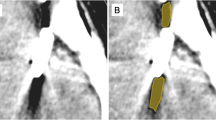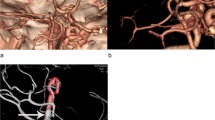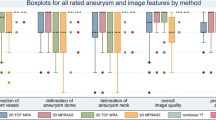Abstract
Purpose
To determine the diagnostic accuracy of 3D-CTA using volume rendering (VR) in the detection of residual or recurrent cerebral aneurysms after clipping.
Material and methods
Between January 2006 and November 2007, 45 patients (20 female, 25 male) with 50 intracranial aneurysms treated using titanium clips were enrolled in this study. IADSA and 3D-CTA were performed within 1 month after surgery in 27 (60%) patients, after 1 year in 12 (26%) patients and after 5 years in six (13%) patients. In blinded fashion, CTA and DSA images were independently interpreted by two senior neuroradiologists with 7 years of experience in vascular diagnostic neuroradiology. The diagnostic performance of MDCTA compared with DSA for the detection of aneurysm remnants was measured by receiver operating characteristic (ROC) analysis. The area under the ROC curve, 95% confidence interval (CI), sensitivity, and specificity were calculated.
Results
For the detection of residue–recurrent aneurysm; the sensitivity and specificity of MDCTA were 87.5% (95% CI = 52.9–97.8%) and 97.4% (95% CI = 86.5–99.5%) for the first reader and 87.5% (95% CI = 52.9–97.8%) and 100% (95% CI = 90.8–100%) for the second reader respectively. Receiver operating characteristic (ROC) analysis revealed good diagnostic performance for 3D-CTA (mean area under ROC curve (Az) = 0.98 and 0.99 for the first and the second observer, respectively) The kappa values extracted from the interobserver concordance analysis for agreement observers regarding the use of MDCTA for assessment of a remnant neck was 0.62.
Conclusion
Using MDCTA, it is possible to demonstrate the status of intracranial aneurysms after surgical clipping in the immediate postoperative period as well as long-term follow-up with an high sensitivity and specificity when comparing with the findings of DSA.



Similar content being viewed by others
References
Cloft HJ, Joseph GJ, Dion JE (1999) Risk of cerebral angiography in patients with subarachnoid haemorrhage, cerebral aneurysm, and arterio-venous malformation: a meta-analysis. Stroke 30:317–320
Schwartz RB, Tice HM, Hooten SM, Hsu L, Stieg PE (1994) Evaluation of cerebral aneurysms with helical CT: correlation with conventional angiography and MR angiography. Radiology 192:717–722, Sep
Korogi Y, Takahashi M, Katada K, Ogura Y, Hasuo K, Ochi M et al (1999) Intracranial aneurysms: detection with three-dimensional CT angiography with volume rendering—comparison with conventional angiographic and surgical findings. Radiology 211:497–506
Kato Y, Katada K, Hayakawa M et al (2001) Can 3D-CTA surpass DSA in diagnosis of cerebral aneurysm? Acta Neurochir (Wien) 143:245–250
Caruso R, Colonnese C, Elefante A, Innocenzi G, Raguso M, Gagliardi FM (2002) Use of spiral computerised tomography angiography in patients with cerebral aneurysm. Our experience. J Neurosurg Sci 46:4–9
Van Loon JJ, Yousry TA, Fink U et al (1997) Post-operative spiral computed tomography and magnetic resonance angiography after aneurysm clipping with titanium clips. Neurosurgery 41:851–856
Sakuma I, Tomura N, Kinouchi H et al (2006) Post-operative three-dimensional CT angiography after cerebral aneurysm clipping with titanium clips: detection with single detector CT. Comparison with intra-arterial digital subtraction angiography. Clin Radiol 61:505–512, Jun
Teksam M, McKinney A, Cakir B, Truwit CL (2004) Multi-slice computed tomography angiography in the detection of residual or recurrent cerebral aneurysms after surgical clipping. Acta Radiol 45(5):571–576, Aug
Feueberg I, Lindquist C, Lindqvist M, Steiner L (1987) Natural history of post-operative aneurysm rests. J Neurosurg 66:30–34
David CA, Visteh AG, Spetzler RF, Lemole M, Lawton MT, Partovi S (1999) Late angiographic follow-up review of surgically treated aneurysms. J Neurosurg 91:396–401
Cloft HJ, Joseph GJ, Dion JE (1999) Risk of cerebral angiography in patients with subarachnoid haemorrhage, cerebral aneurysm, and arterio-venous malformation: a meta-analysis. Stroke 30:317–320, Feb
Burtscher IM, Owman T, Romner B, Stahlberg F, Holtas S (1998) Aneurysm clip MR artefacts. Titanium versus stainless steel and influence of imaging parameters. Acta Radiologica 39:70–76
Lee JH, Kim SJ, Cha J et al (2005) Post-operative multidetector computed tomography angiography after aneurysm clipping: comparison with digital subtraction angiography. J Comput Assist Tomogr 29(1):20–25, Jan–Feb
van der Schaaf I, van Leeuwen M, Vlassenbroek A, Velthuis B (2006) Minimising clip artefacts in multi CT angiography of clipped patients. Am J Neuroradiol 27(1):60–66, Jan
Author information
Authors and Affiliations
Corresponding author
Additional information
Comments
In this interesting study, the authors deal with an important and intensely debated issue. At the non-invasive era, the need for DSA represents a serious and cumbersome drawback and it is tempting to consider CTA instead. Yet, failure of CTA to securely disclose abnormal findings has limited its implementation as DSA replacement.
In the present study, the authors should be commended for their ability to reach very high level of confidence with the use of CTA with very demonstrative illustrations to support their point. Although, the paper is rather confirmatory in substance, it has the merit to be well written and to summarize a carefully performed study.
Jean F. Soustiel
Rambam Medical Center, Haifa
This is an interesting study, analysing the diagnostic accuracy of volume rendered CT angiography in the detection of residual or recurrent cerebral aneurysms after surgical clipping as compared to the gold standard digital subtraction angiography.
Istvan Szikora
National Institute of Neurosurgery, Budapest
Rights and permissions
About this article
Cite this article
Uysal, E., Ozel, A., Erturk, S.M. et al. Comparison of multislice computed tomography angiography and digital subtraction angiography in the detection of residual or recurrent aneurysm after surgical clipping with titanium clips. Acta Neurochir (Wien) 151, 131–135 (2009). https://doi.org/10.1007/s00701-009-0184-x
Received:
Accepted:
Published:
Issue Date:
DOI: https://doi.org/10.1007/s00701-009-0184-x




